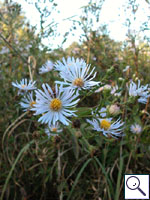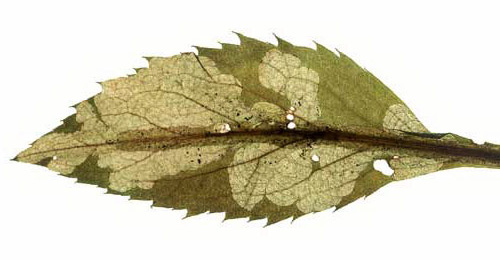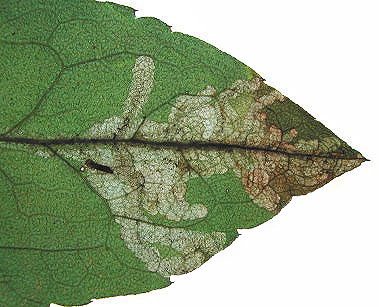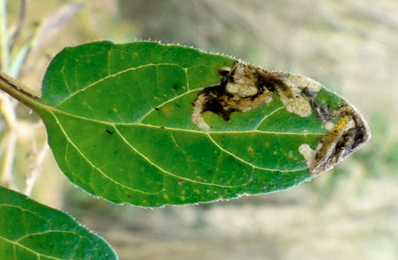 |
||
(Coleoptera, Diptera, Hymenoptera and Lepidoptera) by
Brian Pitkin, Willem Ellis, Colin Plant and Rob Edmunds |
||
ASTER. Asters and Michaelmas-daisies. [Asteraceae] | |
About thrity-one species of Aster are recorded in Britain including the native Goldilocks Aster (A. linosyris) and Sea Aster (A. tripolium) and the introduced European Michaelmas-daisy (A. amellus), Glaucous Michaelmas-daisy (A. laevis), Narrow-leaved Michaelmas-daisy (A. lanceolatus), Hairy Michaelmas-daisy (A. novae-angliae), Confused Michaelmas-daisy (A. novi-belgii) and Nettle-leaved Michaelmas-daisy (A. schreberi). The BSBI provide a downloadable plant crib for Aster. Twenty-four or twenty-five British miners are recorded on Aster. A further species, the agromyzid Phytoliriomyza perpusilla may mine Aster tripolium in S. England. The polyphagous agromyzids Liromyza huidobrensis, Liriomyza sativae and Liriomyza trifolii have been recorded in quarantine in Britain (Pitkin & Plant in British leafminers). See also Liriomyza species in Glasshouses and/or Quarantine Interceptions. |
 Michaelmas Daisy Aster tripolium |
The agromyzids Melanagromyza tripolii and Napomyza tripolii bore the stems of Aster in Britain and elsewhere. Coleophora obscenella is recorded feeding on seeds of Solidago virgaurea and occasionally on Aster tripolium (see British leafminers). A key to the European miners recorded on Aster is provided in Bladmineerders van Europa. |
|
Key for the identification of the known mines of British |
||
Note: Diptera larvae may live in a corridor mine, a corridor-blotch mine, or a blotch mine, but never in a case, a rolled or folded leaf, a tentiform mine or sandwiched between two more or less circular leaf sections in later instars. Pupation never in a cocoon. All mining Diptera larvae are leg-less maggots without a head capsule (see examples). They never have thoracic or abdominal legs. They do not have chewing mouthparts, although they do have a characteristic cephalo-pharyngeal skeleton (see examples), usually visible internally through the body wall. The larvae lie on their sides within the mine and use their pick-like mouthparts to feed on plant tissue. In some corridor miners frass may lie in two rows on alternate sides of the mine. In order to vacate the mine the fully grown larva cuts an exit slit, which is usually semi-circular (see Liriomyza huidobrensis video). The pupa is formed within the hardened last larval skin or puparium and as a result sheaths enclosing head appendages, wings and legs are not visible externally (see examples). See Key to non-Diptera. |
||
1a >Stem-miner: A narrow, inconspicuous stem mine. Pupation at the end of the mine (Spencer, 1976: 64). Fine, upper- or lower-surface corridor, ending in a thick vein. From there the mine extends finally to the rind of the stem. There also the pupation takes place, usually not far from the root collar. Mines in the stem rind often are conspicuous through a red discoloration. |
||
|
||
Ophiomyia curvipalpis (Zetterstedt, 1848) [Diptera: Agromyzidae]. |
||
1b > Leaf-miner |
||
|
||
Pegomya depressiventris (Zetterstedt, 1845) [Diptera: Anthomyiidae]. |
||
2a > Leaf-miner: Corridor mine following the mid-rib, with lateral offshoots. |
||
2b > Leaf-miner: Mine not primarily above midrib. |
||
3a > Leaf-miner: A distinctive mine primarily above mid-rib, with irregular short lateral offshoots into leaf blade. Pupation external (Spencer, 1972: 51 (fig. 172), 55; Spencer, 1976: 270, 271 (fig. 486)). Branched, whitish, upper-surface corridor; main axis overlying the midrib; side branches overlying the main lateral veins. (In Campanula and Phyteuma the mine is much less branched, sometimes nothing more than a corridor on top of the midrib). Frass in rather long strings. Usually the mines begins as a long and narrow, shallow, tortuous lower-surface corridor that ends upon the midrib but otherwise is not associated with the leaf venation. Often this initial corridor is filled with callus, and then even less conspicuous. Pupation outside the mine. A linear mine on the upper surface, usually following the midrib and showing side branches along the veins. The frass is in strings. |
||
|
||
|
||
Liriomyza strigata (Meigen, 1830) [Diptera: Agromyzidae]. |
||
3b > Leaf-miner: Broad corridor overlying the midrib. The mine has a number of side branches that distally widen strongly, and may coalesce. Primary and secondary feeding lines very conspicuous. Pupation external, in soil. |
||
 Mine of Cornutrypeta spinifrons on Senecio ovalis Image: © Willem Ellis (Bladmineerders van Europa) |
||
|
||
Cornutrypeta spinifrons (Schroeder, 1913) [Diptera: Tephritidae]. |
||
4b > Leaf-miner: Pupation external. |
||
5a > Leaf-miner: Mine narrow, irregular linear; initially on lower surface but mainly upper surface. Pupation internal (Spencer, 1972b: 87). Initially lower-surface, later upper-surface corridor, not appreciably widening towards the end. Corridor often strongly contorted. Frass in rather coarse grains, irregularly scattered. Pupation in the mine. |
||
|
||
Chromatomyia asteris (Hendel, 1934) [Diptera: Agromyzidae]. |
||
5b > Leaf-miner: Mine linear, whitish, both upper and lower surface. Pupation internal, at the end of the mine with the anterior spiracles projecting through the epidermis (Spencer, 1976: 433). Upper-surface, less often lower-surface corridor. Frass in isolated grains. Pupation within the mine, usually in a lower-surface puparial chamber. A long whitish upper surface corridor, which eventually goes lower surface. |
||
|
||
Chromatomyia
horticola (Goureau, 1851) [Diptera: Agromyzidae] |
||
5c > Leaf-miner: A long, winding leaf-mine on the upper surface of the leaf, with frass widely-spaced in conspicuous black lumps. Pupation internal, at the end of mine (Spencer, 1972b: 28 (fig. 68), 29). |
||
|
||
Ophiomyia maura (Meigen, 1838) [Diptera: Agromyzidae]. |
||
6a > Leaf-miner: A linear mine commencing with a conspicuous regular spiral and then continuing a considerable distance more or less straight (Spencer, 1976: 245). Upper-surface corridor. The first part is wound in a dense spiral that quickly turns brown. The spiral continues in a long, generally unbranched corridor that maintains almost the same width. Frass in long thick strings. When the mine is positioned near the leaf margin the spiral part may be missing; the thick frass strings then are sufficiently characteristic. Pupation outside the mine; exit slit in lower epidermis. Long upper surface gallery starting with a spiral of 6 to 8 turns (as shown). Frass in conspicuous narrow linear lines. |
||
|
||
Liriomyza eupatorii (Kaltenbach, 1873) [Diptera: Agromyzidae]. |
||
1b > Leaf-miner: A narrow upper surface linear branching mine without apparent feeding lines. Frass in isolated grains and pearl chains. At least in Erigeron older mines turn reddish-brown. Pupation external (Spencer, 1976: 413. |
||
|
||
Phytomyza erigerophila Hering, 1927 [Diptera: Agromyzidae]. |
||
6c > Leaf-miner: An irregular linear mine, which in small leaves can form a secondary blotch. Puparium orange |
||
|
||
Liriomyza pusilla (Meigen, 1830) [Diptera: Agromyzidae]. |
||
6d > Leaf-miner: A short linear mine in first instar, later producing a circular or oval blotch. Frass is excreted in a black mass prior to pupation; puparium firmly glued with frass within the mine (Spencer, 1976: 306). Large, whitish, upper-surface blotch, preceded by a short corridor that often is overrun later by the developing blotch. The larva hardly produces any frass; the few grains that are present are black and rather coarse. But when the larva is about to pupate, it empties its intestine, which has the effect that the puparium is anchored in the mine by dried frass. The initial gallery by the first instar larva then leads to a whitish blotch. The puparium is fixed to the inside of the mine by an accumulation of frass. |
||
|
||
Calycomyza humeralis (von Roser, 1840) [Diptera: Agromyzidae]. |
||
6e > Leaf-miner: The pale-coloured mine runs on the upper side irregularly to the sides, in the middle with blackish spots, where the frass is deposited. It starts in the center of a leaf and without a small mine leading to a large mine. Many mines in a leaf could finally cover the whole leaf. |
||
 Mine of Pegomya nigrisquama Image: © Rob Edmunds (British leafminers) |
||
|
||
Pegomya nigrisquama (Stein, 1888) [Diptera: Anthomyiidae]. |
||
6f > Leaf-miner: The mine begins as a long, quite narrow corridor, usually not far from the tip of a leaf segment. Usually this corridor follows the leaf margin for some distance, but it may also run freely through the blade and may then be stongly contorted. In the end the corridor is directed towards the midrib, where an elongated blotch is formed, overlying the midrib and some of the larger lateral veins. Frass in a nearly continuous line in the initial corridor, in scattered lumps in the later part of the mine. Primary and secondary feeding lines very conspicuous when seen in transparancy. Pupation outside the mine. The mine starts as a very narrow corridor, usually close to the tip of a leaf segment and following the leaf margin. The later section of the corridor approaches the main vein, where an elongated blotch is made with long broad finger like extensions that lay over the secondary veins. In the initial corridor the frass forms an almost continuous line, in the blotch it is distributed in large scattered lumps. In fresh mines the secondary feeding lines are clearly visible. |
||
|
||
Trypeta zoe Meigen, 1826 [Diptera: Tephritidae]. |
||
6g > Leaf-miner: A large, brownish blotch, with conspicuous feeding lines. Pupation external (Spencer, 1972b: 62 (fig. 205), 63; Spencer, 1976: 308, 309 (fig. 557)). Large, brown, upper-surface blotch with conspicuous primary and secondary feeding lines. The feeding lines are the more apparent because the semiliquid frass adheres to them. Pupation outside the mine; exit slit in the upper epidermis. A short broad gallery, normally at the margin, leading to a blotch with obvious feeding lines in whorls. Mines go brown. |
||
|
||
Nemorimyza posticata (Meigen, 1830) [Diptera: Agromyzidae]. |
||
|
Key for the identification of the known mines of British |
Note: The larvae of mining Coleoptera, Hymenoptera and Lepidoptera may live in a corridor mine, a corridor-blotch mine, a blotch mine, a case, a rolled or folded leaf, a tentiform mine or sandwiched between two more or less circular leaf sections in later instars. Larva may pupate in a silk cocoon. The larva may have six legs (although they may be reduced or absent), a head capsule and chewing mouthparts with opposable mandibles (see video of a gracillarid larva feeding). Larvae of Hymenoptera and Lepidoptera usually also have abdominal legs (see examples). Frass, if present, never in two rows. Unless feeding externally from within a case the larva usually vacates the mine by chewing an exit hole. Pupa with visible head appendages, wings and legs which lie in sheaths (see examples). |
1# > ? Leaf-miner: Details unknown. |
|
Pegomya depressiventris (Zetterstedt, 1845) [Diptera: Anthomyiidae]. |
1a > Leaf miner and case-bearer: The larva lives outside the mine, protected by a case, and feeds on the underlying plant tissues via a hole cut in the epidermis. Mine does not contain frass |
1b > Leaf-miner, but not a case-bearer: The larva lives inside the mine. Mine usually contains frass |
2a > Leaf-miner and case-bearer: A relatively large (12-15 mm), dark brown, lightly curved two-valved sheath case with a narrow ventral keel. Mouth angle 30-45. |
|
Coleophora conspicuella Zeller, 1849 [Lepidoptera: Coleophoridae]. |
2b > Leaf-miner and case-bearer: Tubular silken case, up to 8 mm long. Behind the mouth the case is sharply bent; as a result the mouth angle is 0° and is the case aprressed to the substrate. |
|
Coleophora linosyridella Fuchs, 1880 [Lepidoptera: Coleophoridae]. |
| 2c > Leaf-miner and case-bearer: Tubular silk case, about 9 mm long, trivalved, with a mouth angle of about 20°. |
|
Coleophora ramosella Zeller, 1849 [Lepidoptera: Coleophoridae]. |
2d > Leaf-miner and case-bearer: A straw-coloured, slender, three-valved tubular silken case; length about 10 mm, mouth angle 45° - 60°. Larva on the leaf underside. Perhaps because of the plant's dense felt cover, the case is attached with much silk, giving the holes a conspicuous white margin. |
|
Coleophora trochilella (Duponchel, 1843) [Lepidoptera: Coleophoridae]. |
3a > Leaf-miner: Rather long full depth corridor that winds freely through the leaf and may cross itself. In the end the corridor widens considerably. Frass mostly in a narrow central line, but may also be deposited along the sides or be missing. The larvae regular leave a mine to restart elsewhere. Pupation outside the mine. Neither larva or mine can be distinguished from that of related species. |
|
Apteropeda orbiculata (Marsham, 1802) [Coleoptera: Chrysomelidae]. |
3b > Leaf-miner: The larva creates a narrow gallery containing black or brownish frass, and subsequently one or more shorter mines or windows. At first a long, narrow, corridor with brown or black frass in a central line; the mine may be upper- or lower-surface of even interparenchymatous, and often enters the cortex of the stem. After some time this mine is vacated and the larva starts making several short full depth blotches. Some larvae keep this habit until short before pupation, others soon begin window-feeding. The larva pupates in a white ribbed cocoon and is illustrated in UKMoths. |
|
Bucculatrix maritima Stainton, 1851 [Coleoptera: Chrysomelidae]. |
3c > Leaf-miner: In the first instar the larva mines the leaves, forming short, irregular, blotch-like mines, but in later instars it lives externally, feeding in spun leaves and often twisting those of tender shoots. Larval head light-brown or yellowish brown, edged with black postero-laterally, ocellar area blackish; prothoracic plate black edged with whitish anteriorly; abdomen dull dark green; pinacula distinct, black, sometimes brownish but with black bases to setae; anal plate large, black (Bradley et al., 1973). Small, full depth mine without a definite shape; little frass. Some silk is deposited in the mine. The larva soon leaves the mine and continues feeding among spun leaves. |
|
Cnephasia incertana (Treitschke, 1835) [Lepidoptera: Tortricidae]. |
3d > Leaf-miner: Rather narrow corridor, untidy and sometimes branched, starting from the base of the leaf, in particular the midrib. Sides of the corridor irregularly eaten out, not really parallel. Frass mostly present, and then in a central line. The larva is capable of leaving the mine and start a new one elsewhere. These later mines are much broader, and the frass is scattered irregularly.. |
 Mine of Orthochaetes insignis on Prunella vulgaris Image: © Jean-Yves Baugnée (Bladmineerders van Europa) |
|
Orthochaetes insignis (Aube, 1863) [Coleoptera: Curculionidae]. |
3e > Leaf-miner: Long, extremely narrow lower- or upper-surface corridor, with a black or brown central frass line. After a while this primary mine is vacated, and the larva starts making shorter, much broader, full depth blotch mines. In the end the larva lives free among spun leaves. |
|
Scrobipalpa salinella (Zeller, 1847) [Lepidoptera: Gelechiidae]. |
|
3f > Leaf-miner: Larvae in blotch-like mines. Most frass is ejected through a small opening in the mine. Fresh mines are very difficult to find. The larvae can leave their mine and restart elsewhere. Pupation external in a mud-covered cocoon on the ground. |
|
Scrobipalpa instabilella (Douglas, 1846) [Lepidoptera: Gelechiidae]. |
| Last updated 09-Jul-2020 Brian Pitkin | ||
